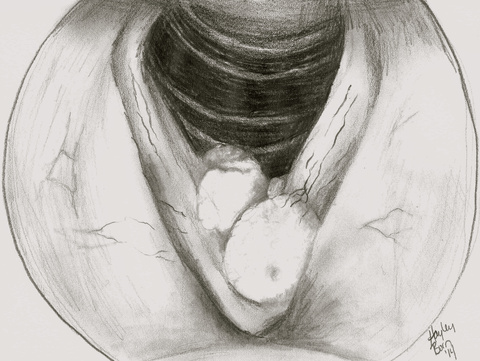See also:
- Pharmacotherapy for Recurrent Respiratory Papillomatosis
- Oropharyngeal Cancer, HPV, and Patient Counseling
- Microdebrider Suction Modulator for RRP
- Microdirect Laryngoscopy case example
- Custom Dental Guards for Micro Direct Laryngoscopy (Suspension Laryngoscopy)
- KTP Laser for the Larynx
- KTP Laser for RRP local anesthesia case example
This protocol was last updated before 2020
Introduction

- Recurrent respiratory papillomatosis is an HPV related neoplasm affecting the larynx and surrounding tissues
- Two separate subtypes, juvenile onset (diagnosis <12 years of age) and adult onset (typically diagnosed between the second and fourth decades)
- It is the most common benign largyngeal tumor is children and is fairly common in adults; 4.5 per 100,000 children and 1.8 per 100,000 adults in the United States
- Most commonly caused by HPV types 6 and 11, subtypes commonly associated with genital warts
- Benign; though significant morbidity owing to repeated ablative procedures
- Potiential for malignant transformation - about 3%; dysplasia is seen in about 50% of biopsies
Juvenile Onset
- Associated with being the first born child, low maternal age, vaginal delivery, maternal history of genital warts - thought to be acquired during passage through birth canal
- Typically regresses around puberty
- Symptoms: hoarseness, breathiness, respiratory distress, obstruction and aphonia
- Physical exam: flexible laryngoscopy shows verrucous, polypoid growths on the true and false vocal folds, the subglottis and/or the trachea
- Treatment: debulking with cold knife, KTP laser
- Interval between procedures varies: average 4.4 per year (range <1 to 19)
- Younger age of onset (years 1-3) is associated with more agressive lesions
- Severe lesions may require trachotomy, not ideal due to increased risk of lower respiratory lesions
- Alternatives/adjuvents: cidofovir, bevacizumab, HPV vaccination interferon, photodynamic therapy, carbinol, acyclovir, vitamin A, pulsed-dyed laser therapy and more - not strong evidence for/against
Adult Onset
- Associated with male gender (64-90% male predominance), higher number of sexual partners (>11 lifetime partners), questionably higher prevalence of oral sex
- High prevalence of HPV in oral cavity of patients and their partners - may have implications for counseling
- not generally considered "contagious" though HPV transmission may have implications regarding lifetime risk of head and neck cancer
- Less likely to develop lower respiratory lesions
- Symptoms: hoarsness is most common, rarely respiratory compromise in adults
- Physical exam: flexible laryngoscopy shows verrucous, polypoid growths usually confined to the true and false folds, occasionally extending into the subglottic or supraglottic spaces, though rare on first presentation
- Treatment: debulking with cold knife, KTP laser -
- Interval between procedures varies and tends to lengthen over time
- Initial and period biopsies should be taken to rule out malignant transformation, no set frequency is accepted
- Need for tracheotomy exceedingly rare in adult onset RRP
- Alternatives/adjuvents: cidofovir, bevacizumab, HPV vaccination, interferon, photodynamic therapy, carbinol, acyclovir, vitamin A, pulsed-dyed laser therapy and more - not yet strong evidence for or against these
Future Directions/Conclusions
- RRP is a typically benign, yet morbid disease caused by HPV infection of the larynx
- Requires repeated, sometimes lifetime procedures to rid the vocal folds or surrounding tissues of lesions
- Future directions: medical adjuvant therapy validation (cidofovir, HPV vaccination, bevacizumab, etc.); prevention (HPV vaccine, sexual health practices)
- Likely that prevalence will decrease with increased use of the HPV vaccine
Excellent review providing a contemporary (2015) approach to counseling reference Taliercio et al 2015 JAMA Otolaryngol below
References
Taliercio S, Cespedes M, Born H, Ruiz R, Roof S, Amin MR and Branski RC: Adult-onset recurrent respiratory papillomatosis: a review of disease pathogenesis and implications for patient counselling. JAMA Otolaryngol Head Neck Surg 2015 Jan 141(1):78-83
Born H, Ruiz R, Verma A, Taliercio S, Achlatis S, Pitman M, Gandonu S, Bing R, Amin MR, & Branski RC (accepted; in press). Concurrent Oral Human Papilloma Virus Infection in Patients with Recurrent Respiratory Papillomatosis. The Laryngoscope.
Ruiz, R., Achlatis, S., Verma, A., Born, H., Kapadia, F., Fang, Y., Pitman, M., Sulica, L., Branski, R. C. and Amin, M. R. (2014), Risk factors for adult-onset recurrent respiratory papillomatosis. The Laryngoscope. doi: 10.1002/lary.24730
Kashima HK, Shah F, Lyles A, et al. A comparison of risk factors in juvenile-onset and adult-onset recurrent respiratory papillomatosis. Laryngoscope 1992;102:9–13.
Gillison ML, Broutian T, Pickard RK, et al. Prevalence of oral HPV infection in the United States, 2009–2010. JAMA 2012;307:693–703.
Larson DA, Derkay CS. Epidemiology of recurrent respiratory papillomatosis. APMIS 2010;118:450–454.
Yiu Y, Fayson S, Smith H, Matrka L Implementation of Routine HPV Vaccination in the Management of Recurrent Respiratory Papillomatosis. Ann Otol Rhinol Laryngol. 2019 Apr;128(4):309-315. doi: 10.1177/0003489418821695. Epub 2018 Dec 29.
Matsuzaki H, Makiyama K, Hirai R, Suzuki H, Asai R, Oshima T.Multi-Year Effect of Human Papillomavirus Vaccination on Recurrent Respiratory Papillomatosis. Laryngoscope. 2019 Apr 8. doi: 10.1002/lary.27993. [Epub ahead of print]
Pham CT, Juhasz M, Sung C, Mesinkovska NA.The Human Papillomavirus Vaccine as a Treatment 1 for HPV-related Dysplastic and Neoplastic Conditions: A Literature Review.J Am Acad Dermatol. 2019 May 11. pii: S0190-9622(19)30714-5. doi: 10.1016/j.jaad.2019.04.067.
